Creative Ideas for Framing Your Bathroom Mirror
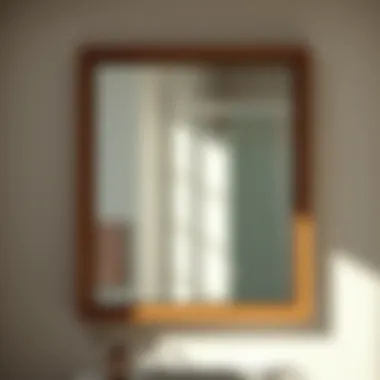
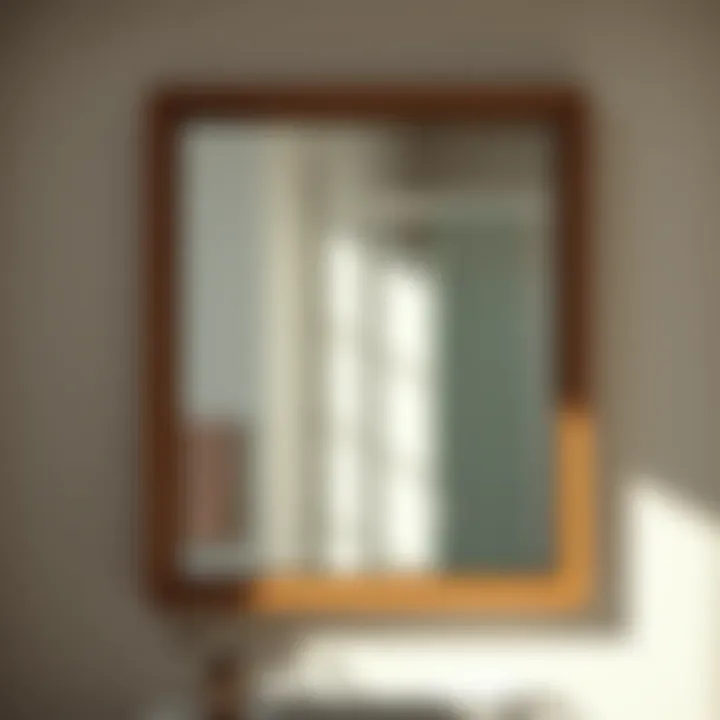
Intro
Framing a bathroom mirror may not seem like a significant task, yet it holds the power to alter the entire vibe of the room. Just think about it; a well-framed mirror can create a focal point that draws the eye and adds an undeniable flair. This project isn’t just about reflection; it’s about personal expression and functional aesthetics.
In a world where bathroom design gets as much attention as the living space, framing your mirror can transform it from ordinary to extraordinary. Whether you're leaning toward a sleek modern look or a cozy rustic feel, this guide covers various materials, styles, and techniques.
Why focus on details like this? Well, a bathroom is more than just a utilitarian space. It's a sanctuary, a retreat, where personal style can shine. A framed mirror enhances both beauty and practicality, ensuring every glance offers a dose of inspiration. Through this article, I aim to equip homeowners and design enthusiasts alike with the insights needed to elevate their bathroom environment usefully and artfully.
Intro to Bathroom Mirror Framing
Framing a bathroom mirror is often overlooked, yet it plays a vital role in transforming the overall aesthetic of the space. Many people might not realize that a well-framed mirror can elevate not just the mirror itself, but the entire ambiance of the bathroom. It's not only about looking good; it's about creating a harmonious flow that reflects your personal style and functional needs.
A thoughtfully framed bathroom mirror can serve multiple purposes. It can act as a focal point, drawing the eye and setting the tone for the entire room. Moreover, it can provide a sense of depth and space, making a small bathroom feel larger. With so many options on the table, it’s essential to grasp the various aspects of mirror framing when you embark on this creative journey. Not only will this guide offer you the nuts and bolts of the framing process, but it will also give you insights into how to select materials and styles that seamlessly integrate into your existing decor.
Additionally, a framed mirror can add a touch of sophistication that can make a personal bathroom feel like a spa getaway. It shows that you have paid attention to detail, creating a welcoming environment for both yourself and guests. Bathroom mirror framing is a practical upgrade that yields lasting benefits, making it a worthy investment.
The Importance of Framing
When it comes to bathrooms, mirrors are often a non-negotiable component. Their utility is clear, but framing them connects that utility with an expressive element. A decent frame does not just surround the mirror; it enhances it, acting almost as a piece of art itself. Think of a frame as the finishing touch that brings everything together—much like a cherry on top. Without it, a mirror can feel stark and uninviting.
Good framing also helps to prevent the edges of the mirror from chipping, providing longevity and enhancing safety. This is particularly important in a bathroom setting, where moisture and humidity can wreak havoc on unprotected materials. By selecting an appropriate frame, you can extend the life of your mirror while simultaneously reflecting your style choices—minimalist, vintage, or perhaps something with a bit more flair.
Overview of Available Options
Selecting the right frame for your bathroom mirror can feel overwhelming given the myriad of choices out there. From traditional wooden frames to sleek metallic finishes, the options span the spectrum from classic to contemporary.
Here’s a brief overview:
- Wood: Wood offers a timeless and versatile choice. Whether it's painted or natural wood, it can warm up the bathroom vibe.
- Metal: For those who prefer a modern aesthetic, metal frames like stainless steel or wrought iron provide a sleek touch and are highly durable.
- MDF and Laminate: Cost-effective yet stylish, these materials offer a budget-friendly option while allowing for intricate designs.
- Glass Accents: Adding glass can introduce a contemporary flair, perfect for those wanting to create an elegant and airy feel.
Understanding the distinct features and benefits of each material is crucial as these elements will not only dictate the style but also the overall functionality of your framed mirror. Choosing wisely will ensure that the mirror enhances your bathroom to its fullest potential.
Design Considerations
When it comes to framing your bathroom mirror, the design considerations are not just about aesthetics; they play a pivotal role in how the space feels and functions. A well-framed mirror can become the centerpiece of a bathroom, affecting the light, space perception, and overall vibe of the room. In this section, we'll unpack a few vital elements that should guide your choices, honing in on style preferences, how to mesh with existing decor, and the reality of space constraints.
Style Preferences
The first stop on your design journey is understanding style preferences. Whether your heart beats for the sleek lines of modern minimalism or the warm textures of rustic charm, your mirror frame must echo those choices. Imagine a Farmhouse bathroom, light wood beams overhead, with a distressed mirror frame that screams character. Alternatively, picture a high-end, spa-like retreat, where a thin, polished chrome frame reflects elegance.
It's crucial to identify what style resonates with you:
- Contemporary: Clean edges, bold colors, and innovative materials can elevate the modern bathroom.
- Vintage or Retro: Frames with intricate carvings or weathered finishes can lend a timeless feel.
- Industrial: Metal frames with a raw finish can add an urban touch.
Setting your preferences early helps you avoid the common pitfall of mismatched decor which can make a bathroom feel disjointed or chaotic.
Integration with Existing Decor
Integrating with existing decor is another cornerstone of successful mirror framing. A framed mirror is not an island, especially in smaller spaces like bathrooms. It needs to interact harmoniously with other elements. For instance, if your vanity boasts warm wood tones, consider a frame that harmonizes with that palette. On the other hand, a bright white frame could create a lovely contrast against darker fixtures. Think about these factors:
- Color Coordination: Choose colors that complement or contrast strategically with other fixtures in the room.
- Material Match: Ensure that the materials used in the frame tie back to other elements such as cabinetry and light fixtures.
- Style Cohesion: For a vintage feel, the frame should echo details found in light fixtures or cabinet hardware.
This careful integration ensures that your framed mirror contributes to the overall ambiance instead of sticking out like a sore thumb.

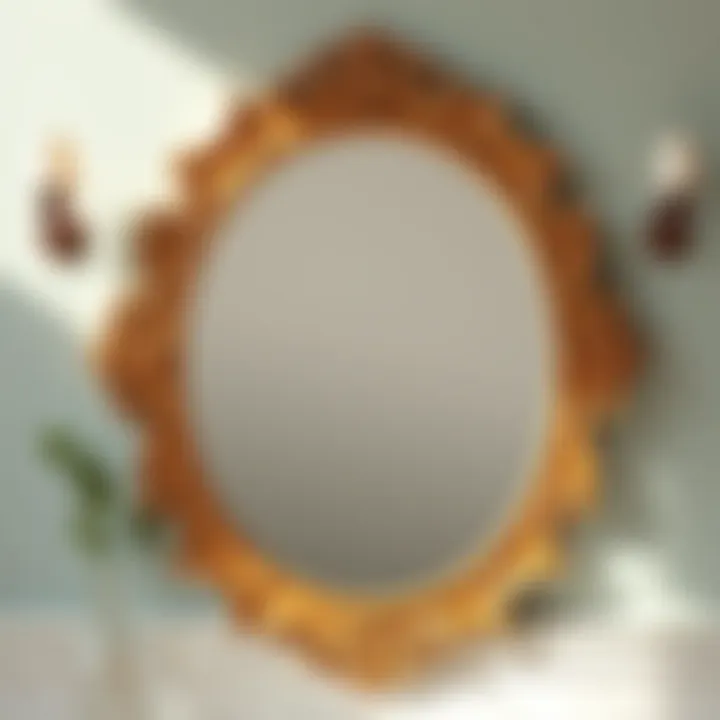
Space Constraints
Space constraints are often underestimated when embarking on the journey of framing a bathroom mirror. A large, ornate frame may seem appealing, but in a compact bathroom, it could look overwhelming. Instead, consider the dimensions of the space. Here are some tips to navigate this:
- Proportion: A frame that’s too small will get lost, while one that's too large can feel oppressive. Striking the right balance can enhance rather than detract from the space.
- Functionality: Ensure that the mirror's height and width make it practical for daily use. Also, consider how the framed mirror might affect traffic patterns in the bathroom.
- Vertical vs. Horizontal: Depending on your wall space, a horizontal frame could create the illusion of width, while a vertical frame might help draw the eye upwards and give the room a more spacious feel.
Material Choices for Mirror Frames
When framing your bathroom mirror, the material choice is very important, as it can greatly influence the overall look and feel of the space. Different materials can provide unique aesthetics and functionality, catering to various personal tastes and design preferences. Choosing the right material helps to ensure that the frame not only complements the mirror but also survives the test of time in a damp environment like a bathroom. Here, we discuss some of the most popular materials to consider, each with its own characteristics and advantages.
Wood: Classic and Versatile
Wood is a timeless choice that can bring warmth and a sense of coziness to a bathroom. It offers a classic appearance that can fit seamlessly into both traditional and contemporary styles. The variety of wood types available, such as oak, walnut, or pine, each provide distinct grains and colors. This versatility allows homeowners to select a finish that matches existing cabinetry or decor.
However, using wood in a bathroom does come with a cautionary tale. Wood can be sensitive to moisture, which may lead to warping or mold over time. To combat this, select a well-sealed finish and consider using a moisture-resistant sealant. Wood frames can also be painted or stained to easily refresh their look when the mood strikes.
Metal: Sleek and Modern
For those leaning towards a more industrial or minimalist vibe, metal frames are an excellent choice. Aluminum and stainless steel are particularly good options, as they are resistant to rust and corrosion, making them ideal for a bathroom environment. Metal frames often offer a sleek, sterile aesthetic that can make the space appear larger and cleaner. Furthermore, metal frames can come in various finishes, including matte, brushed, or shiny. This enables creative freedom in matching with existing fixtures like faucets and towel racks. However, one must be wary of sharp edges and finishes that can scratch easily; always select high-quality materials for a polished look.
MDF and Laminate: Budget-Friendly Solutions
Medium-density fiberboard (MDF) and laminate materials shine as budget-conscious choices without skimping on style. MDF can mimic the appearance of more expensive wood but at a fraction of the cost. It’s very versatile in terms of painting or adding decorative designs since its smooth surface allows for easy customization. Laminate, on the other hand, comes in an endless array of colors and patterns, including those that mimic the look of wood or metal.
While these materials are lightweight and can be easily installed, they may not hold up as well under high humidity. It’s advisable to keep them away from direct water exposure. Overall, these materials are great for achieving a stylish look while keeping an eye on budget constraints.
Glass Accents: A Contemporary Touch
Incorporating glass accents in frame designs can add a modern twist to your bathroom mirror. Frameless options give a sleek appearance, allowing the beauty of the reflection to take center stage. Alternatively, decorative glass can serve as an eye-catching element.
Using frosted glass or tinted pieces can add depth and intrigue. These types of frames can be paired with a variety of other materials—like wood or metal—to create a blended texture and a unique look. While glass can be fragile, using tempered glass can ensure durability and safety, making this an attractive option for various settings.
"Choosing the right material is key to achieving that perfect balance between durability and aesthetic appeal."
Overall, selecting the right material for your mirror frame should not be rushed. Each option has its unique qualities that can significantly enhance your bathroom’s style and functionality, ensuring that you achieve the exact atmosphere you envision for that space.
Essential Tools for Framing
Framing a bathroom mirror can transform an ordinary fixture into a standout focal point. To achieve a professional-looking frame that enhances the mirror's aesthetic, having the right tools is essential. Without these tools, you may find yourself struggling to create straight cuts, accurate measurements, or a secure mount. Let's delve into the critical tools needed for this task, along with some practical tips on selecting the best options.
Measuring Tools for Precision
First off, precise measurements are the backbone of a successful mirror framing project. A good-quality measuring tape, ideally one that locks in place, will help you take accurate measurements of both the mirror and the wall area. This is not just about length; width and depth are just as significant. Moreover, consider a square or a level to ensure that your frame fits properly and hangs straight. When you nail down these dimensions, it just makes everything easier later on.
- Tip: Check for any irregularities on the wall surface where your mirror will hang. Often homes have uneven drywall, and acknowledging this upfront saves time and frustration.
Cutting Equipment for Custom Frames
Once you're equipped with accurate measurements, your next step involves cutting the materials for the frame. A handsaw can work for wood, but a power saw will offer cleaner edges, making for a polished look. If you're working with metal, invest in a good metal miter saw; this ensures that the joints are sharp and well-fitting.
Also, don’t forget about safety gear—goggles and gloves can make a world of difference while you're handling sharp tools.
- Remember: Before you start cutting, layout the components of your frame on a flat surface to visualize how they fit together.
Adhesives and Fasteners: Choosing the Right Options
Once the frame pieces are cut, the next piece of the puzzle is assembly. Here, the choice of adhesives and fasteners plays a pivotal role. For wooden frames, wood glue is a go-to, while metal frames may require epoxy for a strong bond. Fasteners such as screws or brackets are essential for sturdiness, especially where the mirror's weight is concerned.
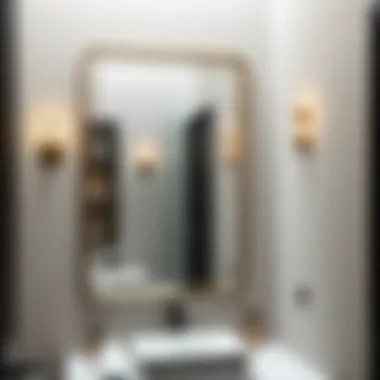
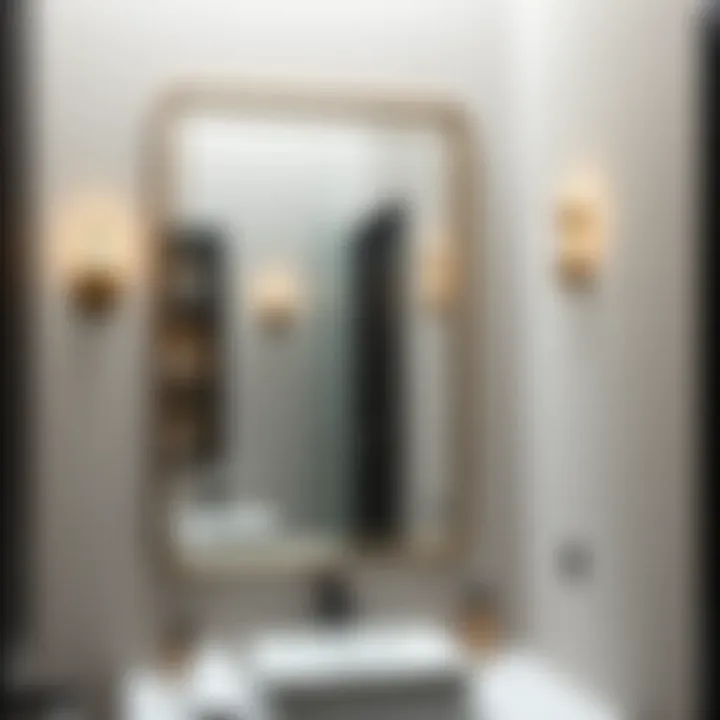
When selecting screws, make sure they are appropriate for the material you are working with. For instance, using drywall screws for wood might not give you the grip required.
Important Note: Always pre-drill holes in wood to prevent splitting and ensure a tight fit.
In summary, the right tools not only simplify the framing process but also increase the quality of your final product. By investing in good equipment, measuring with care, and choosing appropriate adhesives and fasteners, you set the stage for a beautifully framed bathroom mirror. This care will not only save you headaches later but also bring a finished look that elevates your bathroom decor.
Step-by-Step Framing Process
Framing your bathroom mirror isn’t just about aesthetics; it’s a practical task that can dramatically enhance both the style and functionality of your space. By following a step-by-step approach, you can ensure that the frame is crafted with precision, addressing any issues that may arise during the process. This method not only boosts the mirror’s appeal but also adds a personal touch to your bathroom. Each stage is crucial, from the initial preparations to tidying up post-assembly. Here’s a deeper dive into the specifics of this process.
Preparation and Measuring
Before laying hands on the tools, preparation is key. You want to kick things off on the right foot, ensuring everything aligns just so. Start by measuring the existing mirror. Knowing the exact dimensions allows you to create a frame that fits like a glove, avoiding unwelcome gaps. A good tape measure will be your best friend here.
Once you’ve got the numbers down, consider the design. Are you aiming for a rustic appeal or a sleek, modern look? Jot down ideas, perhaps even sketch a rough design. This visual reference can help keep your focus. Further, gather all necessary materials and tools before you get into the nitty-gritty — it saves you from running around mid-project.
Cutting and Assembling the Frame
With your measurements and materials lined up, it’s time to cut the frame pieces to size. Use a sturdy miter saw for the cleanest angles. If you're working with wood, a fine tooth blade minimizes splintering, which is essential for a polished appearance. But pay heed: it’s better to cut slightly larger than too small, as you can always trim down later.
As you assemble the frame, focus on fitting the corners tightly. Wood glue and corner brackets can be helpful allies here. Letting the glue set properly ensures a stable and long-lasting structure. Consider adding decorative touches at this stage, like routed edges or bead molding, to elevate the frame from simple to stunning.
Mounting Techniques
Once your frame is assembled and sturdy, it’s time to mount it securely. Depending on the weight and size of your mirror, the mounting method can vary. For smaller mirrors, adhesive mirror hangers might suffice. However, larger, heavier frames often need more robust solutions. Use wall anchors or screws that fit snugly into your wall structure.
Before finalizing placement, consider visual balance. Step back and gauge how the mirror integrates with the surrounding decor. It should feel harmonious and complement the overall aesthetic of your bathroom. Secure the frame properly, so it withstands daily use without fear of tilting or falling.
"Every stroke of your work, every measurement, adds personality to your space. It’s more than a mirror; it’s a reflection of you."
By following this step-by-step process, you stand to not only enhance the look of your bathroom but also ensure that your hard work pays off in durability and style.
Finishing Touches
Framing your bathroom mirror is a significant step towards personalizing and enhancing the overall aesthetic of your space. However, the final phase, the finishing touches, plays an equally crucial role. It's the cherry on top or, if you will, the icing on the cake. This part decides how the mirror will fit into your bathroom's personality while ensuring it is practical and stylish. Attention to these small details can transform your mirror from a basic design element into a statement piece.
Painting or Staining Options
Choosing to paint or stain your mirror frame opens up a wealth of possibilities that can dramatically alter the look of your bathroom. The color selection is where you can express your creativity and taste. For instance, if your bathroom leans more towards a traditional style, classic shades like cream or pale blue can provide a soft and inviting ambiance. Conversely, if your space follows a modern trend, bold colors or even stark whites could create a clean, minimalist vibe.
When it comes to staining, it’s vital to select a shade that complements your existing fixtures and decor. Rich walnut or warm oak stains work wonders in giving a rustic feel while retaining the natural beauty of wood. Consider these factors:
- Durability: Ensure the paint or stain you choose can withstand the humidity typical of bathrooms.
- Finish Type: Satin finishes tend to hide imperfections better, while high-gloss paints can reflect more light, making the space seem brighter.
- Environmentally Friendly Options: Water-based paints or low-VOC stains can keep your air quality healthy.
"A well-chosen color can mirror not just your style, but also your mood. Think carefully about what you want your frame to convey."
Adding Decorative Elements
After painting or staining, it’s time to think about decorative elements that can add that final touch of flair. Small accents can create a cohesive look and enhance the mirror’s overall appeal. Here are a few ideas to consider:
- Moulding: Adding decorative moulding can enhance elegance, whether it’s intricate or simple. It works especially well for traditional designs.
- Faux Finishes: Techniques like sponging or rag rolling can create a textured look that draws attention without overwhelming.
- Lighting: Integrating LED strip lighting behind the frame can provide both practical and aesthetic benefits. Accent lighting transforms the mirror into a focal point, enhancing its beauty.
- Natural Elements: Incorporate small potted plants or succulents on the shelf below the mirror. Greenery not only livens up the space but also softens hard edges.
Each of these elements can be tailored to align with your design preferences and can deeply impact the charm of the space. The aim is to create an inviting environment, one that resonates with your style while serving functionality, ultimately allowing your bathroom to shine in its true glory.
Common Challenges and Solutions
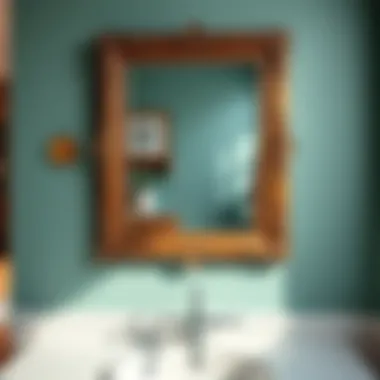
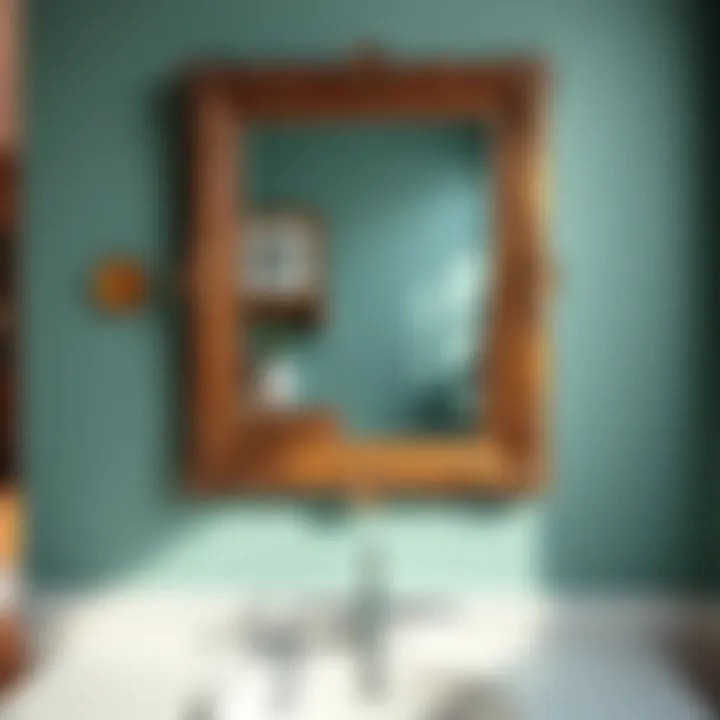
Framing a bathroom mirror can enhance both its functionality and the overall aesthetic of the space. However, homeowners often encounter specific challenges during this process. Understanding these challenges and their corresponding solutions is key to a smooth project. Together, we will delve into the common hurdles faced while framing bathroom mirrors and offer practical solutions that can help you achieve satisfactory results.
Dealing with Uneven Walls
One of the most frustrating issues that can crop up when framing mirrors is encountering uneven walls. In older homes, it’s not uncommon for walls to have slight bumps and dips. These imperfections can throw off the entire look of your mirror frame, making it appear misaligned.
To tackle this problem, it’s essential to begin with precise measurements. Use a level to determine where the wall slopes or rises. Once you have this information, consider creating a shim. A shim is simply a thin piece of material that can help fill gaps or support areas where the wall isn’t level. Using wood or even cardboard, you can build up the frame in uneven areas, creating a more cohesive look.
Addressing Size Discrepancies
Size discrepancies can also complicate the mirror framing process. You may find that the frame you’ve created is slightly bigger or smaller than the mirror itself. This can occur when measurements are taken inaccurately or if the mirror's dimensions differ from standard sizes.
For this situation, cutting your frame's dimensions to fit the mirror snugly will be crucial. You can use a circular saw or a hand saw to trim the wood for a tighter fit. If you find your frame is smaller, consider adding some decorative molding or edging around the mirror. This not only addresses the size issue but also gives the mirror a more finished look.
Ensuring Secure Mounting
When it comes to mounting your newly framed mirror, ensuring its security is of utmost importance. A poorly mounted mirror can not only ruin the aesthetics of your space but also pose safety hazards.
First, choose the right mounting hardware. Make sure to use anchors that are suitable for the weight of your mirror frame, particularly if it is made from heavier materials such as wood or metal. Read the packaging to find out if the anchors will suffice for your chosen mirror size. Secondly, ensure you are drilling into wall studs for maximum support. If you must drill into drywall, don’t skip the anchors; they will provide that extra stability needed to keep the mirror in place over time.
Maintaining Your Framed Mirror
Taking good care of your framed mirror isn’t just about keeping it shiny. It encompasses preserving the structural integrity and enhancing the decoration of your bathroom space. Neglect can lead to deterioration, affecting both appearance and functionality. Dust, moisture, and accidental smudges can accumulate, dulling that reflective brilliance and, in the worst case, damaging the frame or the mirror itself.
Regular maintenance increases the lifespan of your bathroom mirror and keeps it looking as splendid as the day it was framed. Focusing on an intentional cleaning routine and preventive measures will not only elevate the aesthetic but also save time and effort down the line.
Regular Cleaning Practices
Cleaning your framed mirror should be part and parcel of your bathroom routine. Just like you wouldn’t let dust settle on your favorite piece of art, your mirror deserves that same level of attention. Here are some recommended practices to keep it in pristine condition:
- Use a Soft Cloth: Microfiber cloths are ideal as they trap particles without scratching the surface. Avoid abrasive materials which could mar the finish.
- Glass Cleaner or Vinegar Solution: Spray a small amount of glass cleaner on the cloth or mix equal parts water and vinegar for a homemade solution. Wipe in circular motions to eliminate streaks.
- Dry Thoroughly: After cleaning, ensure you dry the mirror well to prevent water spots that can leave an unsightly finish.
- Wipe Down the Frame Too: Don’t neglect the frame! Use a damp cloth tailored to its material, whether wood, metal, or something else entirely.
By implementing these simple yet effective steps, you’ll keep your mirror gleaming without much fuss.
Preventive Maintenance Tips
To proactively guard against future problems, consider these preventive tips:
- Humidity Control: Bathrooms tend to be humid spaces. Using a dehumidifier or exhaust fan can help minimize moisture accumulation that breeds mold or mildew not only on the mirror but in the surrounding areas too.
- Regular Inspections: A little check-up now and then can save trouble later. Look for any signs of wear, such as peeling finishes or cracks in the frame, and address them before they escalate.
- Strategic Placement: Ensure your mirror is placed away from water fixtures to limit splashes that may bring grime and stains.
- Avoid Harsh Chemicals: Stay away from cleaners containing ammonia or bleach. They can damage both the mirror surface and the frame over time.
These tips may seem small, but they make a world of difference. Maintaining your framed mirror not only protects your investment but also keeps your bathroom looking its absolute best.
Remember, a well-maintained mirror can reflect your style and personal touch, enhancing the overall ambiance of your space!
For more information on mirror care and maintenance, consider checking resources like Wikipedia or other credible home improvement sites.
Epilogue
Wrapping things up, framing your bathroom mirror is more than just a decorative task. It serves both aesthetic and functional purposes that can enhance the overall look of your space and add value to your home. Picking the right frame not only compliments your mirror, but it can also create a cohesive look that ties in with your bathroom decor.
Recap of Key Points
Throughout this article, we covered several essential aspects of framing bathroom mirrors:
- The importance of a well-framed mirror in reflecting light and adding a touch of elegance.
- Understanding different design styles, from vintage to contemporary, helps identify what best suits your home.
- The various material choices available, each offering distinct looks and functionalities, such as wood for warmth or glass for modern appeal.
- Essential tools and techniques for a smooth framing process ensuring quality results.
- Solutions for common challenges, including uneven walls and size mismatches, proving that no hurdle is too big to overcome.
- Regular maintenance tips to ensure the framed mirror continues to shine for years to come.
Final Thoughts on Personalizing Your Space
As you conclude this journey into the world of bathroom mirror framing, consider how even small adjustments can serve to personalize your space. This isn’t just about framing a mirror; it's about creating an environment that resonates with you. A customized frame can reflect your personality. Whether you've opted for a rustic wooden touch or a sleek metallic finish, it all tells a story about who you are and what you value in your home.
Remember, it's those little details that elevate an ordinary bathroom into a sanctuary. Take the time to choose materials and styles that speak to you, and don't shy away from experimenting with different techniques. With the right approach, you can transform your mirror into a stunning focal point, making your bathroom a more inviting and enjoyable space.
"Every detail of your home should make you feel good."
So go ahead, embrace the opportunity to express your personal style and elevate that bathroom into a unique retreat.















